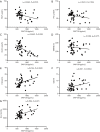Spliceosome-associated protein 130: a novel biomarker for idiopathic pulmonary fibrosis
- PMID: 32953786
- PMCID: PMC7475450
- DOI: 10.21037/atm-20-4404
Spliceosome-associated protein 130: a novel biomarker for idiopathic pulmonary fibrosis
Erratum in
-
Erratum to spliceosome-associated protein 130: a novel biomarker for idiopathic pulmonary fibrosis.Ann Transl Med. 2021 Jul;9(13):1111. doi: 10.21037/atm-2021-5. Ann Transl Med. 2021. PMID: 34423023 Free PMC article.
Abstract
Background: Spliceosome-associated protein 130 (SAP130), a novel danger-associated molecular pattern (DAMP), is involved in inflammatory disease. However, no data are available about SAP130 in idiopathic pulmonary fibrosis (IPF). Our study aimed to investigate SAP130 in the serum and lung tissue of patients with IPF and to determine its clinical significance.
Methods: SAP130 levels in the serum of 83 IPF patients and 38 healthy subjects were measured. Additionally, immunohistochemical staining for SAP130 was performed in lung specimens of IPF patients and control subjects. Correlation between serum SAP130 levels and clinical parameters were investigated.
Results: Serum SAP130 levels were elevated in IPF patients compared with healthy controls. In parallel, the expression of SAP130 in lung tissue was elevated in IPF. SAP130 levels were higher in patients with acute exacerbation of idiopathic pulmonary fibrosis (AE-IPF) than patients with stable IPF (P=0.0144). The area under curve (AUC) of the ROC curve for the diagnosis of IPF was 0.944 (95% CI, 0.810-0.997) for SAP130. The sensitivity (92.1%) and specificity (69.9%) were obtained for the cutoff value of 643.87 pg/mL. In patients with stable IPF, the SAP130 level correlated positively with fibrosis on high-resolution CT (HRCT) (r=0.4164, P=0.0029) and serum KL-6 (r=0.4564, P=0.0010), and inversely with FEV1 (r=-0.3562, P=0.0120) and DLCO (r=-0.5550, P<0.0001). In patients with AE-IPF, the SAP130 level correlated positively with fibrosis (r=0.3735, P=0.0296) and ground-glass opacity (r=0.4697, P=0.0051) on HRCT and serum Krebs von den Lungen 6 (KL-6) (r=0.5470, P= 0.0008).
Conclusions: The study suggested that SAP130 was a potential noninvasive biomarker that correlates well with disease severity of IPF. A prospective, multicentre study is required to validate the clinical and pathophysiological utility of SAP130 in IPF.
Keywords: Idiopathic pulmonary fibrosis (IPF); acute exacerbation; biomarkers; spliceosome-associated protein 130 (SAP130).
2020 Annals of Translational Medicine. All rights reserved.
Conflict of interest statement
Conflicts of Interest: All authors have completed the ICMJE uniform disclosure form (available at http://dx.doi.org/10.21037/atm-20-4404). The authors have no conflicts of interest to declare.
Figures






Similar articles
-
Evaluation of the Diagnostic Efficacies of Serological Markers KL-6, SP-A, SP-D, CCL2, and CXCL13 in Idiopathic Interstitial Pneumonia.Respiration. 2019;98(6):534-545. doi: 10.1159/000503689. Epub 2019 Oct 30. Respiration. 2019. PMID: 31665737
-
The significance of periostin in the diagnosis of idiopathic pulmonary fibrosis and prediction of acute exacerbations.J Thorac Dis. 2025 Mar 31;17(3):1364-1376. doi: 10.21037/jtd-24-1882. Epub 2025 Mar 14. J Thorac Dis. 2025. PMID: 40223944 Free PMC article.
-
Elevated serum human epididymis protein 4 is associated with disease severity and worse survival in idiopathic pulmonary fibrosis: a cohort study.Ann Transl Med. 2022 Sep;10(18):992. doi: 10.21037/atm-22-4042. Ann Transl Med. 2022. PMID: 36267722 Free PMC article.
-
Prognostic role of Krebs von den Lungen-6 (KL-6) measurement in idiopathic pulmonary fibrosis: a systematic review and meta-analysis.Clin Chem Lab Med. 2021 Apr 9;59(8):1400-1408. doi: 10.1515/cclm-2021-0199. Print 2021 Jul 27. Clin Chem Lab Med. 2021. PMID: 33831978
-
Evaluation and management of Idiopathic Pulmonary Fibrosis.Respir Investig. 2019 Jul;57(4):300-311. doi: 10.1016/j.resinv.2019.02.003. Epub 2019 Mar 8. Respir Investig. 2019. PMID: 30853366 Review.
Cited by
-
The risks of using unapproved gene symbols.Am J Hum Genet. 2021 Oct 7;108(10):1813-1816. doi: 10.1016/j.ajhg.2021.09.004. Am J Hum Genet. 2021. PMID: 34626580 Free PMC article.
-
Ambiguity about Splicing Factor 3b Subunit 3 (SF3B3) and Sin3A Associated Protein 130 (SAP130).Cells. 2021 Mar 8;10(3):590. doi: 10.3390/cells10030590. Cells. 2021. PMID: 33800128 Free PMC article.
-
KL-6 as an Immunological Biomarker Predicts the Severity, Progression, Acute Exacerbation, and Poor Outcomes of Interstitial Lung Disease: A Systematic Review and Meta-Analysis.Front Immunol. 2021 Dec 9;12:745233. doi: 10.3389/fimmu.2021.745233. eCollection 2021. Front Immunol. 2021. PMID: 34956179 Free PMC article.
-
Examination of the role of necroptotic damage-associated molecular patterns in tissue fibrosis.Front Immunol. 2022 Aug 30;13:886374. doi: 10.3389/fimmu.2022.886374. eCollection 2022. Front Immunol. 2022. PMID: 36110858 Free PMC article. Review.
-
The Role of Epithelial Damage in the Pulmonary Immune Response.Cells. 2021 Oct 15;10(10):2763. doi: 10.3390/cells10102763. Cells. 2021. PMID: 34685744 Free PMC article. Review.
References
LinkOut - more resources
Full Text Sources
Other Literature Sources
Research Materials
